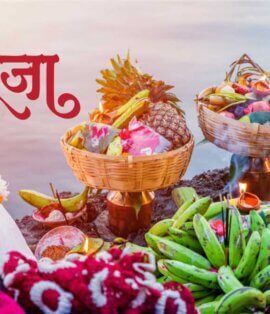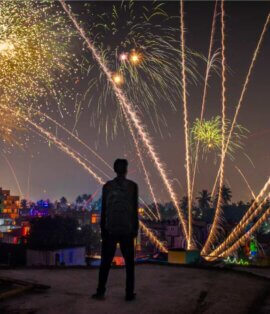Hartalika Teej is a vibrant Hindu festival with special significance for married women and young girls, primarily in India and Nepal. This festival celebrates the devotion of Goddess Parvati and her divine marriage to Lord Shiva. It is a day marked by fasting, prayer, and rituals aimed at seeking blessings for marital bliss, the longevity of husbands, and general well-being. For unmarried women, it is an occasion to pray for an ideal husband in the future. As we approach Hartalika Teej 2025, celebrated on August 26, 2025, let’s dive deeper into the festival’s history, significance, rituals, temples to visit, and regional celebrations.
The Legend and Significance of Hartalika Teej
The name “Hartalika” comes from the mythological story of Goddess Parvati. According to the legend, Parvati, who was deeply devoted to Lord Shiva, wanted to marry him. However, her father, King Himavan, had arranged for her to marry Lord Vishnu. Unwilling to accept this, Goodess Parvati’s friend kidnapped and hid her in a forest. The word “Hartalika” literally means “abduction by a friend” (Har means abduction, and Talika means a friend).
The heart of this story symbolises Parvati’s determination and devotion to Lord Shiva. She had been fasting and praying to win his love, and in her heart, she believed that only through devotion would she be able to marry him. Finally, Lord Shiva accepted her as his consort due to her persistence and dedication. Hartalika Teej thus marks the triumph of devotion over all obstacles, with women observing this festival in honour of Parvati’s unwavering love and determination.
Rituals and Observances of Hartalika Teej
Hartalika Teej is a day of devotion, fasting, and worship, with specific rituals and practices that vary slightly across regions. Here’s an overview of the most common rituals observed:
- Fasting (Nirjala Vrat): One of the main features of Hartalika Teej is the strict fast observed by women. This fast, known as Nirjala Vrat, is waterless, meaning women abstain from food and water for 24 hours. It is believed that observing this fast with complete devotion ensures their husbands’ long life and well-being.
- Bathing and Purification: The day begins with a sacred bath, which is considered an important ritual to cleanse the body and soul. It is customary to wear new clothes, preferably green or red, and apply henna (mehendi) to the hands and feet.
- Worship of Lord Shiva and Goddess Parvati: Women offer prayers and perform puja (ritual worship) to Lord Shiva and Goddess Parvati. The idols of the deities are often made of clay and adorned with flowers, offerings, and traditional items like incense sticks, coconut, and fruits. It is believed that by invoking the blessings of Lord Shiva and Goddess Parvati, women can secure their families’ happiness, health, and longevity.
- The Vrat Katha (Fasting Story): A significant part of the day’s observances includes the recital of the Vrat Katha, a sacred story narrating the legend of Hartalika Teej. The katha describes Parvati’s dedication and the love story between her and Lord Shiva.
- Traditional Songs and Dances: Women gather in groups to sing traditional songs known as “Teej Geet.” These songs describe the festival’s beauty, Parvati’s longing for Lord Shiva, and the joy of married life. It is also a time for women to bond and celebrate sisterhood. The day is filled with traditional dances, prayers, and a strong sense of community.
- Night Vigil (Jagran): Many women stay awake throughout the night, singing devotional songs and engaging in prayer. The night vigil is believed to strengthen their devotion and bring blessings.
Traditional Dishes Prepared During Hartalika Teej
As with any major festival, Hartalika Teej is associated with specific foods, many of which are prepared and enjoyed after the completion of the fast. Some of the most popular dishes include:
- Gujiya: A traditional sweet dumpling made with a filling of khoya (evaporated milk) and dry fruits, which is deep-fried to a crispy texture and then soaked in sugar syrup.
- Malpua: A pancake-like dessert made from flour, sugar, and coconut, which is fried and soaked in syrup.
- Thekua: A dry sweet made from wheat flour, jaggery, and ghee, popular in Bihar and Uttar Pradesh.
- Sabudana Kheer: A dessert made from tapioca pearls, milk, and sugar, often consumed after a fast.
- Atte Ka Halwa: A semolina-based dessert with ghee, sugar, and cardamom.
- Coconut Laddoo: Sweet balls made from grated coconut and sugar, often prepared as offerings during the festival.
These delicious dishes symbolise the cultural richness and culinary traditions associated with the festival.
Temples to Visit During Hartalika Teej
Hartalika Teej is an occasion for spiritual devotion, and many women visit temples to seek the blessings of Lord Shiva and Goddess Parvati. Some of the most prominent temples that attract devotees during this festival include:
1. Tej Mata Mandir, Jaipur (Rajasthan)
Tej Mata Mandir in Jaipur is one of the central temples for Teej celebrations in Rajasthan. It is dedicated to Goddess Parvati and attracts hundreds of devotees during the festival. In Jaipur, the celebrations include processions, traditional songs, and various rituals. Women offer prayers for marital bliss and long-lasting happiness.
2. Mahakaleshwar Temple, Ujjain (Madhya Pradesh)
Ujjain is home to one of the twelve Jyotirlingas of Lord Shiva, the Mahakaleshwar Temple. This temple holds immense spiritual significance, and devotees from India come here during Hartalika Teej to offer prayers. The temple’s grandeur and the spiritual atmosphere make it a popular destination for those seeking divine blessings.
3. Radha Krishna Temple, Dallas (USA)
For those outside India, the Radha Krishna Temple in Dallas offers an opportunity to celebrate Hartalika Teej with traditional rituals. The temple organises cultural events, devotional singing, and fasting on this day, allowing devotees to connect with the festival’s deep spiritual roots.
Regions Celebrating Hartalika Teej
Hartalika Teej is celebrated with fervour not only in India but also in Nepal, and the customs vary from region to region. Here’s a look at how different areas observe the festival:
India
- Uttar Pradesh and Bihar: These regions observe Hartalika Teej with great enthusiasm. Women gather in temples and local community centres to observe the fast and perform the rituals. Preparing traditional sweets such as Thekua and Gujiya in Bihar is common, and women sing songs around the local temples.
- Rajasthan: In Rajasthan, especially in Jaipur, the Teej festival is marked by a colourful procession, where women, dressed in traditional attire, carry idols of Lord Shiva and Goddess Parvati. Women in Rajasthan also fast, sing songs, and gather in temples to offer prayers.
- Madhya Pradesh and Jharkhand: Hartalika Teej is celebrated with cultural programs and community prayers in these regions. The women of these areas traditionally visit temples, sing devotional songs, and gather for festive meals after the fast.
- Maharashtra: In Maharashtra, the festival is known as Hartalika Tritiya Vrat, and women celebrate it similarly with fasting, prayers, and rituals. They worship clay idols of Lord Shiva and Goddess Parvati and prepare traditional foods to break their fast.
Nepal
In Nepal, Hartalika Teej is celebrated with grandeur, especially in Kathmandu. Temples like Pashupatinath become the focal point for celebrations, with thousands of women participating in prayers and rituals. Women gather to sing traditional devotional songs, dance, and celebrate the divine union of Shiva and Parvati.
Conclusion
Hartalika Teej is not just a festival but a beautiful manifestation of devotion, tradition, and cultural significance. Celebrated across India and Nepal, the festival brings together women to celebrate love, marriage, and spiritual dedication. Whether observed in the temples of Ujjain, Jaipur, or Kathmandu, or in the homes of married and unmarried women fasting and praying for their futures, Hartalika Teej continues to be a vibrant and spiritually enriching experience.
As Hartalika Teej 2025 approaches, it is a reminder of the power of love, devotion, and the bond between husband and wife. It is a time to renew one’s spiritual energy, unite with family and community, and seek divine blessings for a prosperous future.






